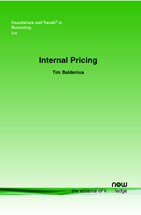Internal Pricing
By Tim Baldenius, Graduate School of Business, Columbia University, USA, tb171@columbia.edu
Abstract
This monograph focuses on the use of incomplete contracting models to study transfer pricing. Intrafirm pricing mechanisms affect division managers' incentives to trade intermediate products and to undertake relationship-specific investments so as to increase the gains from trade. Letting managers negotiate over the transaction is known to cause holdup (underinvestment) problems. Yet, in the absence of external markets, negotiations frequently outperform cost-based mechanisms, because negotiations aggregate cost and revenue information more efficiently into prices. This result is established in a symmetric information setting and confirmed, with some qualification, for bargaining under incomplete information. In the latter case, trading and investment efficiency can be improved by adding non-financial performance measures to a divisional performance measurement system. When the intermediate product can also be sold in an imperfectly competitive external market, internal discounts on external market prices are shown often to improve the efficiency of intrafirm trade and of upfront investments.
Internal Pricing
Internal Pricing surveys of the transfer pricing literature with a focus on commonly-used pricing schemes using incomplete contracting models. Chapter 2 develops the basic symmetric information model to compare the performance of cost-based and negotiated pricing in the absence of external input markets. Chapter 3 considers market-based pricing and the role of internal price adjustments; it ignores investments and focuses solely on trading incentives. Chapter 4 adds investments to the model of Chapter 3 and shows that investment opportunities further strengthen the case for internal adjustments. Chapter 5 reconsiders the initial analysis of Chapter 2 for the case of asymmetrically informed divisional managers. The book ends with the author's conclusions and an appendix including the mathematical proofs. A key theme running through Internal Pricing is that the firm's central office (i.e headquarters) plays a rather limited role in mediating individual transactions. This captures the stylized empirical fact that in most firms, headquarters designs the broad "rules of the game" by choosing a pricing mechanism and compensation contracts, but usually does not get involved in pricing on a product-by-product basis.
